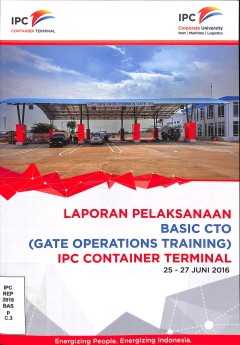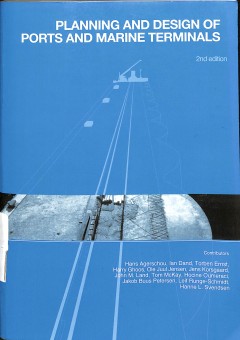Ditapis dengan

Laporan Pelaksanaan Basic Cto (Gate Operations Training) Ipc Container Termin…
- Edisi
- 2016
- ISBN/ISSN
- -
- Deskripsi Fisik
- 12 halaman
- Judul Seri
- -
- No. Panggil
- IPC REP 2016 BAS p C.1
- Edisi
- 2016
- ISBN/ISSN
- -
- Deskripsi Fisik
- 12 halaman
- Judul Seri
- -
- No. Panggil
- IPC REP 2016 BAS p C.1

Planning And Design Of Ports And Marine Terminal
Following from the success of the first edition, written by a collection of eminent figures in the field, this new edition continues to look at the rational planning for port facilities requirements (berths, storage and cargo handling equipment), organisations, management and operations with relation to planning and design of ports and marine terminals.
- Edisi
- 2nd Edition
- ISBN/ISSN
- 978-07277-3498-3
- Deskripsi Fisik
- xviii, 446 p., ; illus : index ; 24 cm
- Judul Seri
- -
- No. Panggil
- LC 627.2 AGE p

Crane Scheduling in Container Terminals : Mathematical Models, Heuristics and…
The globalization of trade has lead to an enormous growth in sea transportation over the last years. A great majority of general cargo is containerized and handled in container terminals, which are essential hubs in sea transportation systems. The potential of cost saving in a container terminal is large and the workflow of a container terminal has to be very efficient. The focus of this book l…
- Edisi
- -
- ISBN/ISSN
- 978-3-639-04236-8
- Deskripsi Fisik
- 59p. ; 23cm.
- Judul Seri
- -
- No. Panggil
- TXT PO BOH c

Research on dry port concept as intermodal node
The shortage of the free space in the port areas is the reason to search for alternatives. This paper focuses on the dry port concept which is a new approach to solving the mentioned problem. The dry port concept is based on moving of intermodal terminals further to hinterland from the port areas. It helps to avoid traffic bottlenecks, to connect cargo handling from the port with other types of…
- Edisi
- Vol XXII, No 3, 207–213
- ISBN/ISSN
- 1648-4142
- Deskripsi Fisik
- 8 p.
- Judul Seri
- -
- No. Panggil
- ATC PO JAR r

Entry mode choices of rapidly internationalizing terminal operators - the det…
The surge of international terminal operators (ITOs) gives momentum to the ongoing internationalization process in ports, and induces academic literature to investigate their overseas growth patterns. Empirical evidence shows that, although most container port operators experience regular internationalization drives, several firms pursue an unconventional and accelerated foreign expansion proce…
- Edisi
- -
- ISBN/ISSN
- -
- Deskripsi Fisik
- 30 pages
- Judul Seri
- -
- No. Panggil
- ATC PO SAT e

Empirical analysis of influence factors to container throughput in korea and …
Over the past years, the Eastern Asia has become an important market in world shipping network. Container throughput of China ports like Shanghai and Qingdao shows a significant expansion. Similarly, Korea ports’ container throughput has been on the rise, although the growth trend has recently slowed down. This paper examines the relationships among container throughputs of Korea and China co…
- Edisi
- Volume 27
- ISBN/ISSN
- -
- Deskripsi Fisik
- 26 pages
- Judul Seri
- -
- No. Panggil
- ATC PO LIU e
 Karya Umum
Karya Umum  Filsafat
Filsafat  Agama
Agama  Ilmu-ilmu Sosial
Ilmu-ilmu Sosial  Bahasa
Bahasa  Ilmu-ilmu Murni
Ilmu-ilmu Murni  Ilmu-ilmu Terapan
Ilmu-ilmu Terapan  Kesenian, Hiburan, dan Olahraga
Kesenian, Hiburan, dan Olahraga  Kesusastraan
Kesusastraan  Geografi dan Sejarah
Geografi dan Sejarah